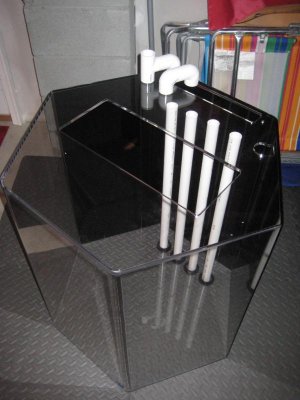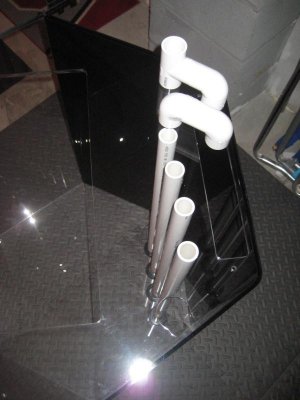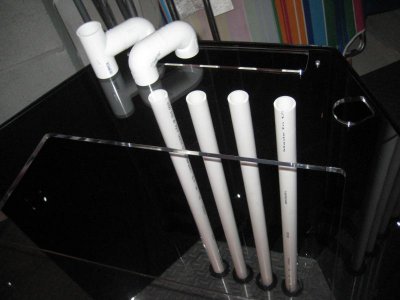Da Maui life
New member
Scroll up just a bit #6133 and the answer you shall find.
Scroll up just a bit #6133 and the answer you shall find.
got a new pump (WB5000 for a 75g) and am having some issues with the overflow....
when the full siphon is set so that it is not creating a vortex, the secondary standpipe is taking on too much flow. When I open up the main siphon gate valve to reduce the amount of flow in the secondary standpipe, it drains the overflow box or creates a vortex. I cant seem to get a happy medium.
the water level in the overflow box is just below the top of the 90s....the actual opening to the bulkhead of the primary siphon is about 1/4" lower than the open standpipe, but I cut the 90s so that there is significant amount of space between the opening of the 90s and the bottom pane of the overflow. all plumbing is 1.5"....my assumption is that 1" plumbing would have solved all of these issues.
i dont know what else to do...any help is appreciated.
maybe still too much space between 90 and overflow bottom ? I'm using WaterBlaster 3000 - my full siphon 1" 90 is only 3/8" off of bottom for what it's worth.
what size plumbing do you have overall?

I finally got my tank plumbed in. 75 gallon to a 40 breeder in the basement and about 750 gph from a Reeflo Blowhole 1450.
The three drains drop 6 feet to the basement ceiling, then go through a slanted section where they drop another 1 foot over 8 feet, then it's another 6 foot drop into the sump and end 1 inch into the water with a gate valve just above the sump on the full siphon.
The tank part is exactly to BeanAnimal's specs with 1.5" PVC, Sanitary tees, cleanout caps, street elbow into an overflow box, etc. It diverges from BeanAnimal's specs because of the nearly horizontal section, and it's this that is causing me trouble, so I'd like suggestions for how to possibly tune it. It's possible that the answer will be that it can't be tuned.
I can tell that it's having trouble getting all the water out of the full siphon pipe. I can turn the gate valve all the way shut and turn the return pump on. The emergency initially kicks in, but gradually the open channel takes over and handles all the flow without going into full siphon mode because I have the tube on the open channel about 1/4 inch above the emergency. It's noisy, as you'd expect. Then I can go downstairs and gradually open up the gate valve. It gets noisier, the water level starts slowly dropping in the box and stabilizes eventually, but it stays noisy.
At one point I opened the valve a full turn more, the box upstairs got really quiet as it managed to push the air out of the line, and then, of course, it drained the overflow box and made flushing noises. If I keep the gate valve closed to the point where it doesn't flush the box, it doesn't seem to be moving fast enough to push the bubbles out of the full siphon and it stays noisy.
I'd like to know what my options are from some of the BeanAnimal gurus here. Should I just wait longer with the stable flow rate to get it to purge the bubbles? I feel if I have it at a stable level with bubbles in the full siphon then as soon as it purges them it will speed up so much that it will flush, no matter what.
Another option would be a larger return pump, maybe double the flow rate so that it could push enough through the siphon to purge the bubbles since I know it's possible to do with a high enough flow. Think that's my best option?
Thanks for any advice.
This is essentially exactly what is happening in my system...i already went to a larger return pump and it didnt fix anything. 1.5" plumbing is capable of handling 5,000gph. I honestly think that 1.5" is too large and require too high of a flow to work with a pump that is pushing a flow rate of about 6-7x overturn for a 75 gallon tank which is ideal...any thoughts here?
I would be willing to go up to 25x or 30x through the sump if I thought that would do it. I am a believer in high flow through the sump.
Seems like downsizing the siphon pipe to increase the flow velocity at the same flow rate would be cheaper, though. May try 1 inch pvc down for just the full siphon before getting a bigger pump.
Trying to borrow a hammerhead or something locally just to test it out.
I'm currently in build mode myself, so take this with six grains of salt, but I'd try varying the heights of the individual pipes - moving the siphon lower in the overflow box than the other pipes may work to make sure that they siphon is going even at the restricted flow from the valve.
The other thing might be to get a more expensive true union ball valve - I got the $25 or so one from BRS, and it is so much more smooth (and able to be micro-controlled) than the ones I picked up at Home Depot.
It's already a smidge lower, actually, like a quarter inch. I cut a bit off the coupling for the open channel just to help it start because I was concerned about my non-standard mod to the overflow system by doing the horizontal pipes and basement sump.
I have a Spears 1.5" gate valve at the moment. It doesn't get much smoother. Hard to tell how far it's open, but that's a largely academic concern once I get the flow rate set right. I'm starting from fully closed and slowly opening it and then waiting a while to see what happens. With these very long drain pipes it seems to be a pretty delayed reaction between tweaking the valve and something happening upstairs.



All the joints are glued but I will go back through and silicone all joints on the stand pipes.
The overflow is very short only 4 inches deep but it is very long, so wouldn't think it would be that.
Thanks for the tips.
When you do your silicone work for the internal overflow, are you guys just making a platform out of wood to set it on while it cures in the aquarium?
I'm placing the horizontal pane first to avoid showing the seam.
Finally at that stage and 65" of overflow better be right.
Cheers,
Adam
My overflow has a lid but I guess they could still get in. I guess I am going to drain the tank then use dremel to cut the teeth out unless there is an easier way. I have been running my bean and it flows a lot of water once I get my teeth cut I think we will be in business. Thanks for the help.
